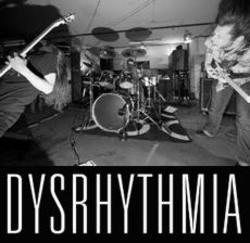Na Marastu se diskografie Dysrhythmie mapuje od desky Pretest, a novinka nebude výjimkou, protože za poslech rozhodně stojí. A Dysrhythmia znovu potvrzuje, že není z těch kapel, které by rády stály, přešlapovaly, šoupaly nohama na místě. Jestli mezi Pretest a Barriers zeje značná mezera a hudební posun, stejně tak tomu je s novinkou oproti předešlým Barriers. Kde se minule přidružil rukopis Marstona, tentokrát vládne přísná metalová ruka a ostnatej obojek kolem krku. S poslechem Psychic Maps doopravdy nepřekvapí, že si Luc Lemay vybral Marstona a Hufnagela pro pokračování Gorguts, stejně tak jsou jasně čitelné Marstonovy blackmetalové úlety Krallice a mazlení s death metalem Indricothere.
K obvyklému arzenálu Dysrhythmie (viz předchozí recenze) se přidává psychedelicky vesmírné blackové bzučení (včelíny), kde je hlavním ukazatelem Krallice, často jsou k zaslechnutí hrátky v méně obvyklých harmonických stupnicích, kde bych se občas nebál přirovnat k již výše zmíněným Gorguts. No a samozřejmě je hodně slyšet vliv Behold... The Arctopus. Místo původního pomalejšího, plazivého rock/stoner základu se pokračuje v tendencích z Barriers and Passages, tedy rychleji a víc věcí zároveň, a rozhodně už v současnosti základy tvoří metal, pyčo, daleko víc se šlape na plyn, tlačí se dopředu, člověk už jen jen čeká kdy uslyší nějakej ten dvoušlapkovej průšlap a prasečí zachrochtání (tentokrát ještě ne, ale kdo ví, co přijde příště).

To ovšem neznamená, že by se Dysrhythmia stala nějakým hudebně stravitelnějším, jednodušším tělesem, spíše naopak. Ačkoli se čerpá z metalových zdrojů, těží se z nich poněkud jiným způsobem, a tak ačkoli deska zní dosti ostře, nesklouzavá se ani k metalové dusavosti, ani k nějaké zuřivé agresi, zůstává charakteristická atmosféra z předchozích desek, lehké éterično, těžká psychedelie, mlživý zvuk, rytmická nekonkrétnost, celková neuchopitelnost. Zároveň je patrný snad až přehnaně kreativní zápal, takřka nikdy není jen jedna linka na sledovaní, vždy se v pozadí, popředí, po stranách, ze shora, ze zdola odvíjí něco dalšího, pod mlživě blackovým bzučením válčí bubny a basa v nečitelných rytmech, v pozadí stonerových houpaček se disharmonicky mihotají kytarové záchvěvy, děje se toho moc, děje se to najednou a děje se to rychle. Díky tomu při prvních posleších ani nejste schopni docenit delikátní práci s motivy, jejich návraty, mocnění, vyšumění, při prvních posleších existuje jen tady a teď a ani tady a teď často nestačíte pobrat, natož abyste je byli schopni pobrat v nějakém celku. Sám, už po slušném počtu poslechů, nezvládám a musím věnovat plnou pozornost, abych si Psychic Maps byl schopen užít.
V jenom odstavci: Dysrhythmia šlape na plyn víc než kdy jindy, rychleji a více linek na jednou, že z toho občas až jde hlava kolem a zvedá se žaludek, mořská nemoc, rychle rotující pouťová atrakce. Navíc se znovu přitvrdilo, přimetalovělo, pronikly boční projekty zejména z Marstonovy strany. Ale pořád se neztrácí kompaktnost, promyšlenost, propracovanost, i když je to zase o něco těžší poslouchat, nelze než složit absolutorium.
Marast maps the discography of Dysrhythmia since the Pretest album, and the new release won’t be an exception as it is definitely worth a listen. And Dysrhythmia proves again that it’s not a band that would like to stand, sit, shuffle feet in a certain place for a long time. If there was a large gap and shifting in musical direction between Pretest and Barriers and Passages, the same holds true for Barriers and the new release. Whereas the last time the dominant new element was the infiltration by Marston handwriting, this time the reign is in firm, strict metal hand and spike collar round the neck. While listening to Psychic Maps you really won’t get surprised anymore that Luc Lemay picked Colin Marston and Kevin Hufnagel to continue with Gorguts, immediately recognizable are the influences of Marston’s black metal experimentation with Krallice and death meatl caressing in Indricothere.
To the ususal weaponry of Dysrhythmia, psychedelic spaceish black metal drone is added, the main indicator being Krallice. Flirting with less usual harmonies comes quite often, comparisons could be drawn at time even to the above mentioned Gorguts. And, obviously, the influence of Behold.. The Arctopus has grown even stronger. Instead of the original sneaky rock/stoner basis the tendecies from Barriers and Passages grow even stronger, faster and more things at the same time to be precise. Without any question the main source of inspiration is metal, the speed pedal gets more and more pressure, pushing straight forward, you are just expecting to hear the triggered blastbeats and pigs squealing any moment, even though it never comes.

This doesn’t mean however, that Dysrhythmia has become a more easily digestible, simpler musical body. Even though the metal is the main inspiration here, the mining is done in quite a different fashion, so even though Psychic Maps have pretty sharp edges, you won’t get the traditional metal trampling sense, nor any explosions of aggression. Still, the atmolsphere from the previous works remains, light ethereal felling, heavy psychedelia, misty, blurred sound, rhythmical dislocation, general failure to be grasped, described easily. At the same, the enthusiastic creativity almost reaches its limits here, there is almost never only one line to follow, in the backgroud, in the centre on the sides, form teh above, from the below there alwas come other lines to follow, under the misty black metal droning rhythmical battles between drums and bass take place, behind the stoner rock swinging trickle disharmonic guitar flows, there are lots happening, tehy are happening fast and they are happening at the same time. During the first contacts with the album you won’t be able to appreciate the delicate work with motives, theirreturns, repetition, dissolving, during the first experiences there exists only here and now and even here and now is sometimes too much, not to metion Psychic Maps as a whole. I myself, after considerable amounts of time spent listening, can’t cope and have to devote full attention to be able to enjoy the listen.
In one paragraph: Dysrhythmia is running faster than ever, fatser and with more lines happening at the same time, sometimes even the head spins round and stomach gets unsettled from these speeds, sea sickness, reckless spinning around of a circus carrousel. The music got even more heavy than last time, more metal, got even more infiltrated by side projects especially form Marston’s side. Still, the disc doesn’t loose compactness, focus, thoughtfullness, sophistication, even though its again a bit harder to listen to than the last time, i can’t but give the full amount.
Translated by Kotek

Vložit komentář